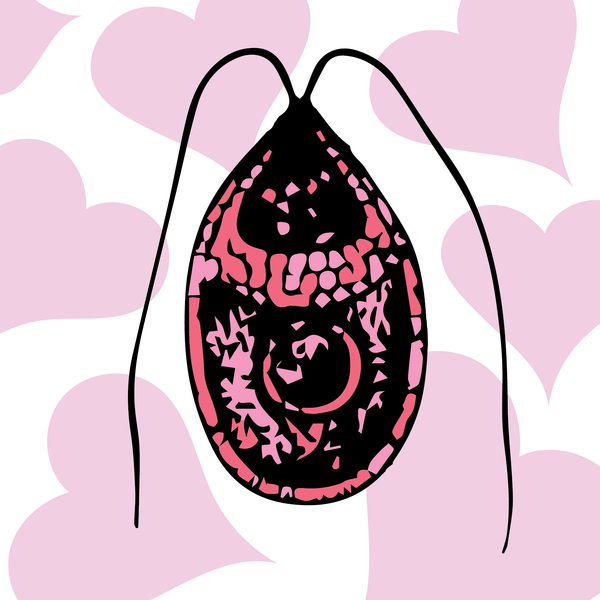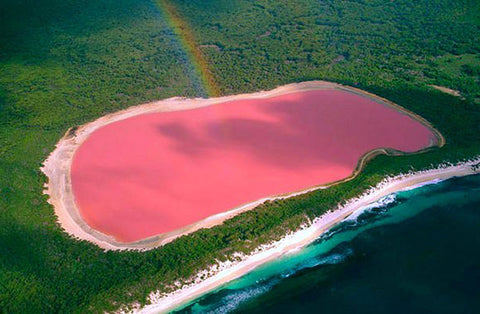Dunaliella salina: the alga that’s always pretty in pink
By: Bethany Kolody

Dunaliella salina is a microalga in the green algae family. But don’t let its pedigree fool you--this little alga is bright pink! So pink, in fact, that it makes this salt lake in western Australia look like it’s made of unicorn dreams1:

Lake Hillier, Australia
D. salina dominates this lake because, as you may have guessed from its name, it’s well-adapted to unusually salty environments. Despite looking like a puddle of strawberry milkshakes, Lake Hillier is actually hypersaline and not at all an easy place for an alga to live. D. salina is considered an extremophile, or an organism that thrives in environments that most others can’t tolerate, because of its rare ability to survive in salty habitats like this one. In fact, D. salina grows optimally at about 1.5–3.0 M NaCl, or about 3-6 times that of average seawater! Even more curiously, as you expose D. salina to saltier environments, the pigment that makes it pink becomes more and more concentrated, indicating that it may have a role in protecting the cell from high salinity2. But D. salina is mostly able to cope with extreme saltiness for two different reasons. Firstly, it doesn’t have a cell wall (only a malleable membrane), allowing it to expand and contract to maintain a live-able internal salt concentration. Secondly, it’s able to produce high volumes of glycerol to balance out the pressure of the salt outside3.
D. salina has been grown in mass culture since the 1960’s4, but believe it or not, its extensive commercial success has had less to do with its ability to survive in extreme conditions and more to do with how very pink it is. All photosynthetic organisms have pigments (like the chlorophyll in plant leaves), but some organisms have more of a variety of pigments than others. D. salina is pink because it has very high levels of a carotenoid pigment called β-carotene. If that sounds vaguely healthy to you, it’s because β-carotene is the pigment that gives a lot of fruits and veggies their color.
For example, a cup of carrot juice has 22 milligrams of β-carotene (think β-“carrot”-ene)5. Luckily for us, β-carotene does more than just make veggies colorful. It is also converted into vitamin A inside your body!6 For that reason, β-carotene is often sold as a dietary supplement. D. salina's bright pink β-carotene stores make it a very valuable (not to mention beautiful!) alga to cultivate. Who knew it would be so healthy to look pretty in pink?
References:
- Solved: Australia’s Pink Lake Mystery - National Geographic. Available at: http://www.nationalgeographic.com.au/nature/australias-pink-lake-mystery-has-been-solved.aspx. (Accessed: 21st May 2017)
- Farhat, N. et al. OPTIMIZATION OF SALT CONCENTRATIONS FOR A HIGHER CAROTENOID PRODUCTION IN DUNALIELLA SALINA (CHLOROPHYCEAE)1. J. Phycol. 47, 1072–1077 (2011).
- Schlipalius, L. The Extensive Commercial Cultivation of Dunaliella salina*. Bioresour. Technol. 38, 241–243 (1991).
- Borowitzka, M., Borowitzka ’, L. J., Borowitzkal, M. A. & Moulton ’, T. P. Production and utilization of microalgae The mass culture of Dunaliella salina for fine chemicals : From laboratory to pilot plant.
- USDA National Nutrient Database for Standard Reference, Release 21. Available at: https://www.ars.usda.gov/northeast-area/beltsville-md/beltsville-human-nutrition-research-center/nutrient-data-laboratory/docs/sr21-reports-by-single-nutrients/. (Accessed: 21st May 2017)
- Olson, J. A. Provitamin A function of carotenoids: the conversion of beta-carotene into vitamin A. J. Nutr. 119, 105–8 (1989).


